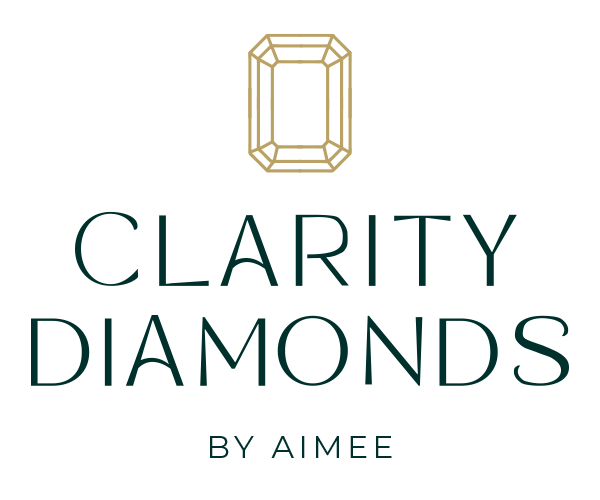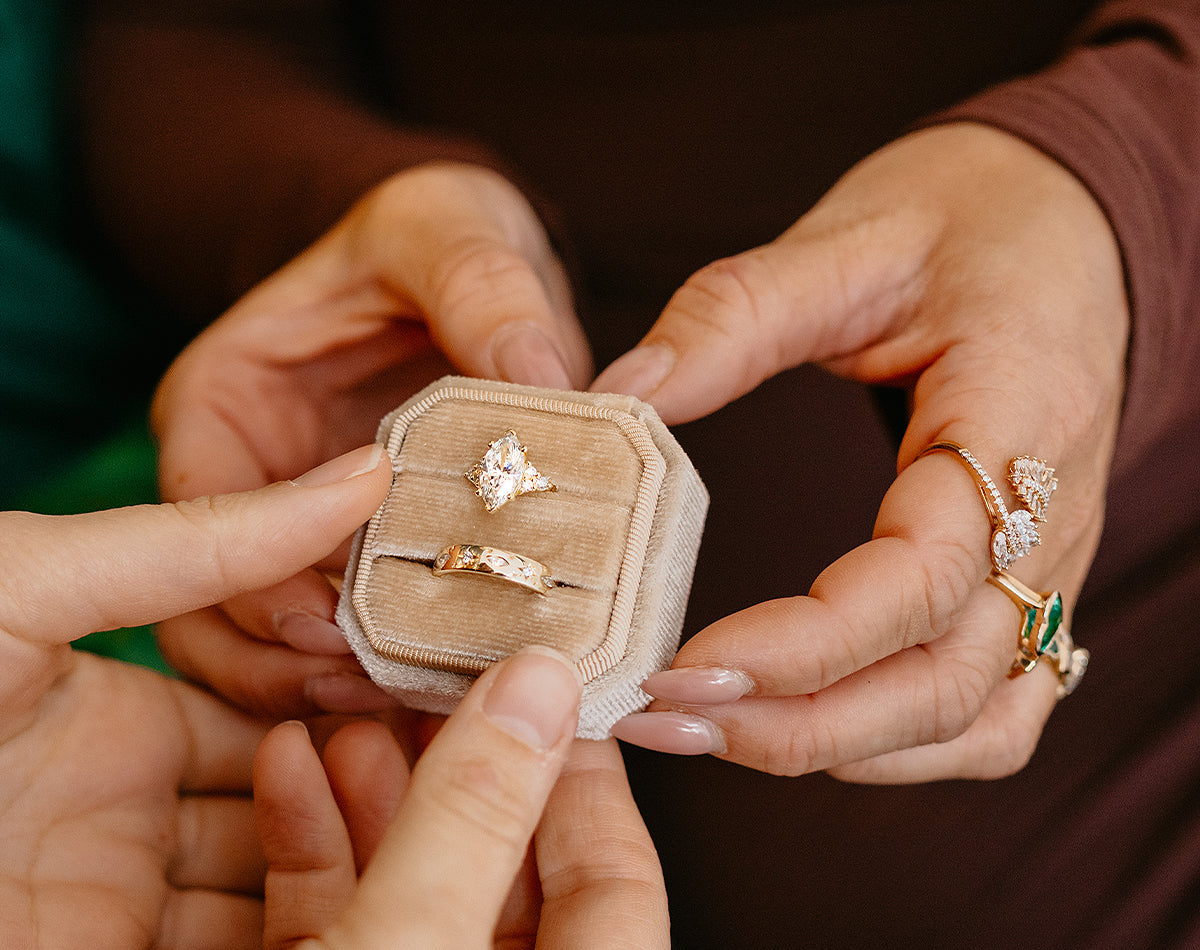
The Diamond 4C’s: My Sparkly Cheat Sheet
Buying jewellery—diamond engagement rings—is so much more than a purchase. It’s a moment, a story, a promise. But let’s be honest, the jargon, the sparkle, the pressure—it’s easy to feel overwhelmed. That’s where I come in - welcome to my sparkly corner of the internet, where every love story is celebrated, whether it’s the start of a new chapter, the honouring of a memory, or simply self-love shining through!
Before I knew everything about diamonds, I used to dream of a dainty 0.30ct engagement ring. These days I’ve got my sights set on dazzling 3.00ct diamond! So, what changed my mind—and why does it matter to you? That’s why I created this honest guide to the 4C’s of diamonds: cut, colour, clarity, and carat. Think of it as your love story’s ultimate guide, helping you find a diamond that fulfills your heart's desires without ever compromising. And who better to tell you about diamonds than a self-proclaimed diamond addict?
Whether your heart is set on simple engagement rings or you fancy an alternative engagement ring, and pieces like Black Diamond engagement rings call to you, there’s a perfect diamond for every story. Together, let’s learn about diamonds, decode the Diamond 4C’s - Colour, Clarity, Cut and Carat, and help you choose a diamond that reflects you in all the right ways.
What is a Diamond and what are the Diamond 4Cs?
A natural diamond is nature’s most enchanting masterpiece—a sparkling symbol of endurance and longevity. Born billions of years ago deep within the Earth, natural diamonds form under intense heat and pressure, transforming pure carbon into the hardest, most radiant gemstone, with countless skilled hands and artisans contributing to the diamond that is set in your jewellery.
A diamond’s beauty is defined using the 4C’s of diamonds—cut, colour, clarity, and carat. These characteristics also determine the diamond’s value. While it’s easy to think you’ll need to sacrifice size to stay within your budget, don’t worry! I’ve shared my top tips for each characteristic, so you can discover your perfect diamond without compromising or overspending.
When searching for the best diamond for an engagement ring or custom ring, a natural diamond is a brilliant reflection of your commitment, with a beauty that stands the test of time. Want to learn more about natural diamonds compared to their manufactured alternative? Check out my Natural vs Lab Grown Diamond Article.
Diamonds Decoded; The 4c’s of diamonds
Diamond Colour
Diamond colour is graded from D to Z, with D being the most colourless and the highest grade possible. As you move down the scale, diamonds show subtle shades of yellow or brown. All colours in diamonds are caused by trace minerals or elements that influence how light is absorbed and reflected within the stone. The colour of a diamond doesn’t affect its durability or brilliance—it's purely a matter of appearance and personal preference. The best diamond colour grade is often considered to be D, but depending on your preferences, you might find beauty in diamonds with warmer hues.
While most diamonds fall within the D to Z scale, coloured diamonds, like pink or black diamonds, offer unique and stunning alternatives and are usually graded on their own specific scale. Pink diamond engagement rings, for example, showcase a romantic and rare colour that adds a personal and unique touch to your special piece.
Aimee Top Tip:
You might be wondering, "Can you tell the difference in diamond colour?" Personally, I recommend staying within the D to H range for a bright, white diamond. This gives you plenty of room to find the perfect diamond within your budget!
Also, if your diamond is set in rose or yellow gold, you can often opt for a colour grade of I, J, or K, as the warmth of the metal can make the colour less noticeable and your perfect Engagement diamond ring more affordable. I myself am a rose gold only wearer, so I often opt for lower colour diamonds which means I get more size for my money which is never a bad thing!
Diamond Clarity
Diamond clarity is graded from FL (Flawless) to I3 (Included), based on the number, size, and visibility of inclusions within the stone. While the highest diamond clarity grade ‘Flawless’ diamonds are free of visible marks, lower grades may feature natural imperfections—known as inclusions—that add character without significantly impacting beauty, especially to the naked eye.
Inclusions are nature’s fingerprints, much like freckles or moles on our skin, and are made of tiny crystals, internal fractures, or structural irregularities that formed during the diamond's creation, making every diamond truly one of a kind. Famous diamonds can even be identified by their inclusions! Since clarity has the least effect on overall sparkle, it’s an area where you can compromise without losing brilliance. Understanding the diamond 4Cs helps you balance beauty and budget with confidence.
Aimee Top Tip:
I recommend opting for SI1 or SI2 clarity, as long as the diamond is "eye clean." An eye-clean diamond has no visible inclusions when viewed without magnification, ensuring it looks flawless to the naked eye.
Visually, there’s no noticeable difference between an eye-clean SI1/SI2 diamond and a Flawless one, but the price difference is substantial. Choosing an eye-clean diamond allows you to enjoy the same brilliance and beauty while keeping costs more manageable. It’s an easy way to balance quality and budget without compromising on appearance. The only exception to this would be step cuts such as Emerald and Asscher cut diamonds, as these cuts are more see through, I recommend staying at VS2 and above.
Diamond Cut
A diamond’s cut is the artistry behind its transformation from rough stone to a breathtaking gem. While clarity and colour play their roles, it’s the cut that determines a diamond’s sparkle, making it the heart of its beauty and brilliance—an essential factor when choosing your perfect stone. The way a diamond is cut will affect its scintillation—how light travels through the stone and makes it sparkle.
Diamond cuts are graded from poor to excellent, with each shape evaluated slightly differently. For example, Round diamonds are assessed on cut, polish, and symmetry, while fancy shapes like ovals or pears are graded on polish and symmetry alone.
A diamond with an excellent grade is a true masterpiece, expertly cut to radiate dazzling light and endless charm.
Diamond Carat
Diamond Carat refers to the weight of a diamond, with 1 carat equal to 200 milligrams. While carat (often shortened to ct) weight influences a diamond’s perceived size, it’s not the whole story. Shape and cut quality also play key roles, meaning two diamonds with the same weight might look different depending on how they’re cut and shaped.
As carat weight increases, so does the price—often exponentially—since larger diamonds are rarer and more sought-after. However, a well-cut diamond can appear larger than its actual weight, thanks to its ability to reflect light beautifully. Understanding the meaning of diamond carat helps you balance size, sparkle, and budget seamlessly.
Aimee top tip:
Diamonds are often sought after in whole numbers—like 1 carat or 2 carats—, usually called “magic numbers” but these come with a premium price tag. A clever way to maximize your budget without compromising on beauty is to choose a diamond carat size just under a whole number, such as 0.9 carats. The slight weight difference of 0.1 carat won’t noticeably impact the diamond’s appearance, especially if it’s well-cut or of high clarity. However, the cost savings can be significant, bringing your dream diamond well within reach and proving that a little compromise on weight can go a long way!
What are the 5 C’s of Diamonds? The Missing Link—Diamond Certification
But wait… I’ve also heard people refer to the Diamond 5 c’s? Let’s talk about the 5 C’s of Diamonds, with Diamond Certification being the link between the Diamond 4C’s’. Certification means a diamond has been sent to a lab where experts assess and agree on its quality. This unbiased evaluation results in an official grading certificate, giving you confidence in your purchase.
GIA, the creators of the grading system, are the most respected and strict, making GIA-graded diamonds highly sought after. Other labs, like IGI and HRD, are also great options for certification, often being more affordable while still offering reliable assessments. Choosing a lab certification depends on your priorities—prestige or budget—but both ensure quality assurance.
I always recommend choosing a diamond certified by an external lab rather than a retailer. Retailer certifications aren’t independently verified, which means they could make a mistake—or worse, misrepresent the diamond. With no way to double-check, you might not get what you’re paying for, and that’s a risk I wouldn’t take!
Aimee Top Tip:
If you’re looking for value, uncertified diamonds can offer incredible discounts—great for maximising your budget! An uncertified diamond doesn’t make a diamond ‘bad’, it just means that the stone hasn’t been put through the expensive process of certification. I personally buy these for my own private collection as you can get a lot more for your money.
Choosing The Perfect Diamond
When it comes to choosing the perfect diamond, especially for affordable diamond engagement rings, understanding the diamond 4C’s—cut, colour, clarity, and carat—will help you make an informed decision, while the 5th C (certification) gives you confidence in your choice and investment.
The diamond is in the detail, and I’m here to guide you every step of the way, ensuring we source a diamond and create a ring that is truly YOU. Browse my collection of ready-to-wear designs, explore my bespoke jewellery service, or get in touch to book a private consultation. Together, we'll find the diamond that makes you sparkle.
Aimee’s final top tip:
Although the GIA diamond grading scale is a great guide, its also important to remember that ultimately diamond grading is only ever an opinion, and you wear the diamond, not the paper work. So make sure what your buying looks good in the flesh, not just on paper, which is why Its important to buy from someone like myself who personally buys and check each stone used within my pieces.
Share

